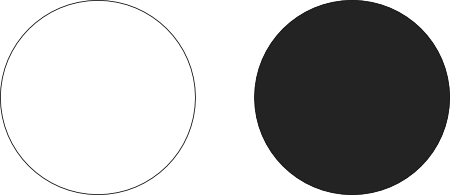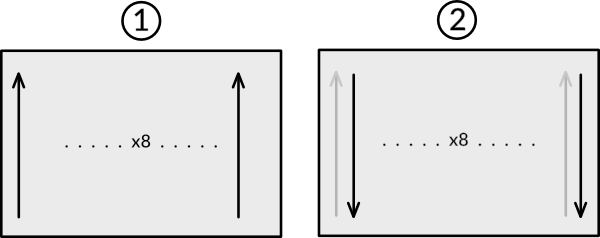The Three Elements of a Marbled Pattern
There are three things to consider when designing a marbled pattern:
- The colour palette
- The initial distribution of colours
- The sequence of strokes
In some designs, there is a certain degree of freedom of choice; in other cases, the three elements have to be matched carefully.
Colour Palette
In theory, you could marble with just two colours, but I don’t think I’ve ever seen a two-colour design. Most marbled patterns seem to have between four and six different colours.
This pattern uses just two colours.

This recreation of a Cockerell pattern uses three colours.

This Half Gelgit uses a four-colour palette.

This Fleur de Lis pattern uses four colours.

This replica of a vintage book cover uses five colours.
This is the palette used in the Circle/Gelgit pattern.


This Olympic Pattern uses six colours.

Initial Colour Distribution
Initial colour distribution in marbled designs ranges from completely random to very precise.
- Totally random. In many cases, in the traditional craft, colours are flicked onto the surface of the medium using a loose brush, resulting in a random spray of coloured dots. Here is an example from YouTube.
- Semi-random. There is a semi-random technique in which colour is placed with a pipette, resulting in a recognisable macro-pattern, but which still has random variations in the details. Here is an example from YouTube.
- Non-random. Occasionally, the colours are placed with a grid-like device, which results in a very precise and regular pattern. Here is an example from YouTube.
(There are lots of marbling videos on YouTube which illustrate the initial distribution of colours.)
Stroke Pattern
There are two types of strokes. Some are made with a single stick, while others are made using several tines mounted on a comb or a rake. Individual strokes can be freehand, while the combs and rakes can only be pulled horizontally or vertically.
(There are lots of marbling videos on YouTube which illustrate the various strokes.)
Almost all traditional marbling patterns can be created with just three different strokes: Straight, Wavy, and Spiral.
Straight Stroke
Straight strokes are almost always horizontal or vertical. They can range from an individual stroke made by hand with a needle to a set of 100 or more strokes made simultaneously using a comb.
Many patterns use a pair of strokes in opposite directions and offset by half the tine gap.
This illustration shows an upward stroke with an eight-tine rake followed by an offset downward stroke using the same rake.

Wavy Stroke
As an alternative to straight strokes, sometimes wavy strokes are used. Their overall direction is still usually vertical or horizontal.
You can see the wavelike strokes in the Peacock, Bouquet, and Serpentine and Bird Wing patterns.

Spiral Stroke
The French Curl is a spiral made by a needle. They can be clockwise or anticlockwise and are also usually laid out in a grid.
Occasionally, circles are used instead of spirals.

Example
sasdfsdf
0 Comments